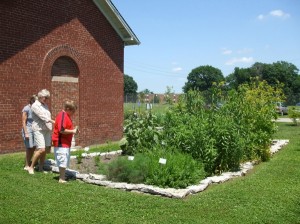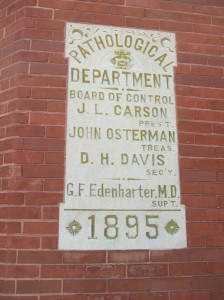
Medicinal Plant Garden. (C) Jo Ellen Meyers Sharp
The gardens around the Indiana Medical History Museum are a beautiful reminder of the link among botany and our health and well being.
For centuries, plants have played a critical role in the treatments of many maladies, from cancer, heart disease, headaches, upset stomachs to insect bites, respiratory problems and more.

A leaf of sage soothes an insect bite on Kathleen Hull's arm. (C) Jo Ellen Meyers Sharp
However, as civilization has become more urbanized, people have lost that connection with nature and plants, a relationship that kept our ancestors alive for centuries, said Kathleen Hull, a retired professor of pathology and laboratory medicine from the Indiana University School of Medicine.
Hull, president Marion County Master Gardener Association, came up with the idea of the Medicinal Plant Garden as companion to the museum. She and Master Gardeners began researching plants and installing them in the gardens in 2003. Master Gardeners maintain the gardens.

Jacob Hinnen of Ionia, Mich., (right) asked his grandmother, Carol Humbracht of Brownsburg, Ind., (center) and cousin, Mary Simmergren, of Long Beach, Calif., to take him to the Indiana Medical History Museum and Medicinal Plant Garden. © Jo Ellen Meyers Sharp
The gardens have a section divided into quadrants, each devoted to a major illness: respiratory, cardio-vascular, digestive and nervous system.
Many of the plants in the medicinal garden are right at home in our gardens, too.
The perennial blue false indigo (Baptisia australis) was used by Native Americans as a purgative or to relieve a toothache. Another perennial, goldenrod (Solidago) is used as a tea for several ailments.
The shrub witch hazel (Hamamelis) is used on bruises, bites and muscular stiffness. And, the perky annual, periwinkle or vinca (Cathranthus roseus) is the source of chemotherapy drugs for Hodgkin’s disease, lymphoma and leukemia.

Dedication stone for Pathology Building at former Central State Hospital. (C) Jo Ellen Meyers Sharp
The gardens and the museum are on the grounds of the former Central State Hospital, 3045 W. Vermont St. The museum is housed in an 1896 building that was state-of-the-art Pathology Building for the mental hospital and was used to study psychiatric disorders. At the time, the thinking was mental illness had its roots in physical illness.
A short walk through the gardens from the museum is the restoration of a doctor’s office, an exhibit that captures what a rural physician’s practice looked like in the mid-20th century.
The museum and gardens operate on donations and do not get any government support. For hours, tours and admissions information, please visit the Web site.
The Medicinal Plant Garden has 79 perennials or annuals, four vines and 14 trees and shrubs, all of which play a role in our health and well being.